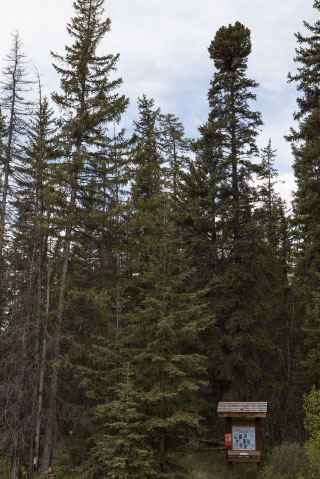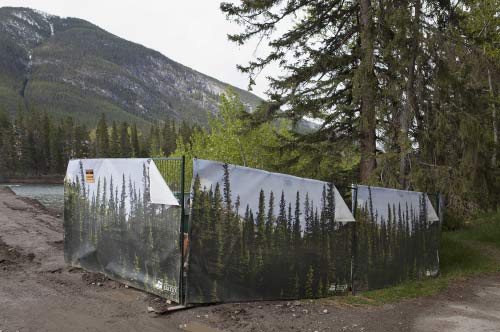
Reading Infrastructure. Theme Park in Paradise
Eva Castringius
Riding my bike between Banff and Canmore allows me to appreciate the physical experience of crossing the border of the Banff National Park. Unlike Banff, Canmore is no longer part of the park; the 1930 National Park Act deemed the town’s mining activities inappropriate and excluded the village from the park.



I follow the new bike path along the Trans Canada Highway, which runs parallel to the railway tracks. Large fences are installed to protect crossing wildlife from the traffic. Or, given that I’m now in a non-park zone, are the fences there to protect crossing traffic from the wildlife? In questioning such territories and their rules, these infrastructural interventions become surreal. The message is highly legible: humans have to protect nature against humans in order to protect their own species.

When the last coalmine was shut down in South Alberta’s Cascade Basin in the late 1970s, the park’s landscape was given a new look geared towards a large-scale, all-season sport and recreation site. Shopping malls, hotels and restaurants characterise the region as much as recreation parks and facilities. The landscape has been adjusted to the demands of modern leisure life. This conflicts with the original idea of the National Park, which was to protect the land and its ecosystems within a restricted area. This tipping of the balance towards controlling (for economic purposes) instead of protecting nature, contains an antagonism that seems, to some degree, rooted in the history of this area.
Cascade Basin has provided opportunities to exploit natural resources since the early 1880s, when the Canadian Pacific Railway (CPR) was built. This made a big impact on the environment that was consolidated in the 1860s, when miners invaded the region; the first coalmining operations opened in Canmore in 1887. The coalmines from Banff and Canmore fed the railway system and in addition fabricated briquettes for the growing population. Cheap labour was needed and was carried out mainly by migrant workers.
The CPR’s general manager, William Cornelius Van Horne (1843–1915) declared: “If we can’t export the scenery, we’ll import the tourists.” With the objective of financing the railroad, in 1887–8 CPR built the Banff Spring Hotel, which became, together with the Banff Hot Springs, a major tourist attraction. The founding of Banff National Park also boosted the establishment of the new tourism industry, designed to appeal to sportsmen and tourists. One result was that the Stoney Tribe was forced to leave the park and was moved to a reserve near Morley.
Back in Banff, these historical narratives are replicated in the village itself, which now resembles a theme park. I photograph its streets, bearing witness to the strange infrastructures that mirror the city’s struggle to simultaneously expand and collapse, its attempt to broach the difficult relationship between Banff National Park and its principal industry: touring paradise.
Download this article as PDF
Eva Castringius
In her art Eva Castringius overlaps the painterly, cinematic and photographic views of landscapes today and produces new constellations of architecture and landscape. Her artistic work shows places whose natural vegetation and topography are reshaped and altered through the use of machines. These landscapes – resources for human need – exist in processes of permanent dissolution and re-formation that can be understood as scenarios of the future that are as threatening as they are fascinating.
- Editorial
Brent Bellamy, Vanessa Boni, Rosie Cooper, Laurie Peake - The Returns of the Past
Nadine Attewell - New Economies of Exchange and the Zombies of Industry
Brent Bellamy - Reading Infrastructure. Theme Park in Paradise
Eva Castringius - The Shifting Sightlines of Montreal’s Silo no. 5
Morgan Charles - Postindustrialisation in the Present Tense
Jeff Diamanti - Using Strategies as Tactics: Liverpool Waters and Irrationality in Banff
Ryan Ferko - Inhabiting Histories
Kate Hoffman and Ada S. Jaarsma - A postcard from Banff
Logan Sisley - Natural Histories
Rafico Ruiz - Everything and Nothing
Fiona McDonald - Docking Infrastructures
Florian Sprenger - How to Know About Oil
Imre Szeman - Elevation and Cultural Theory
Michael Truscello - An Exercise in Understanding Distance
Xinran Yuan - BRiC Library
- Colophon